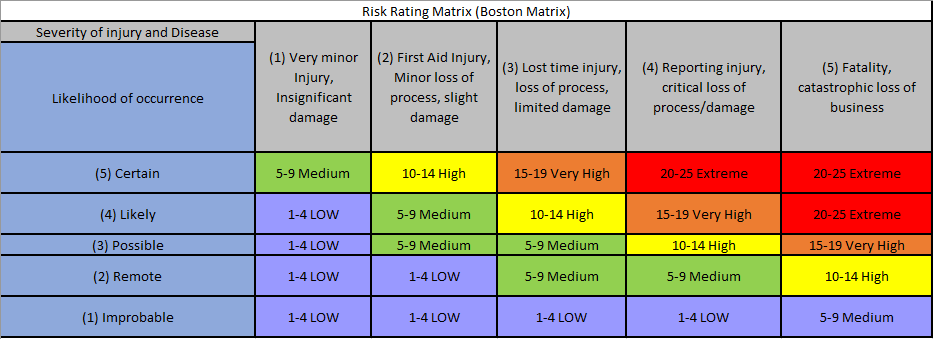Title Page
-
Site condcted
-
Business unit
-
Location of the lift
-
Add a detailed description of the activity
-
Version number
-
Purpose of new issue
- general review (2 years since last review)
- Due to an accident
- Due to change in process
- Risk assessment no longer suitable
-
Add a detailed description of why the activity has been reviewed
-
Assessment Date
-
Review Date
-
Assessor (name)
-
Assisted by (names)
-
Is this an external company undertaking the lift?
-
Name of Company Undertaking the Lift
-
Have they submitted a lift plan?
-
Attach the lifting plan
-
Has the lift plan been reviewed?
-
This task should be stopped until a lifting plan has been completed.
Load Details
-
Description of the Load
-
Total weight being lifted (Kg), including any packaging.
-
Dimensions of the load
-
Are there lifting points on the load?
Lifting Plant, Equipment & Personnel
-
What equipment is being used in this lift?
- Chain
- D-Shackle
- Eyebolt
- Forklift Truck
- Hook
- Lifting reinforced canvas strap
- Lifting Beam
- Pallet Truck
- Overhead sliding joist hoist
- Overhead fixed point hoist
- Other
- Sling
- T-Bolt
-
FLT reference number
-
Does the forklift truck have a current & valid LOLER certificate of thorough examination?
-
The forklift should not be used for this lift
-
Include the LOLER Examination details
-
Is the capacity of the FLT adequate to carry out the task?
-
The forklift should not be used for this lift
-
Provide evidence in the notes as to why it is adequate
-
Equipment reference number
-
Does the lifting beam have a current & valid LOLER certificate of thorough examination?
-
The lifting beam should not be used for this lift
-
Include the LOLER Examination details
-
Is the capacity of the lifting beam adequate to carry out the task?
-
The lefting beam should not be used for this lift
-
Provide evidence in the notes as to why it is adequate
-
Equipment reference number
-
Do the accessories have a current & valid LOLER certificate of thorough examination?
-
The lifting accessory should not be used for this lift
-
Include the LOLER Examination details
-
Is the capacity of the lifting accessory adequate to carry out the task?
-
The lifting accessory should not be used for this lift
-
Provide evidence in the notes as to why it is adequate
-
Lifting equipment required
-
Equipment reference number
-
Does the lifting equipment current & valid LOLER certificate of thorough examination?
-
The lifting equipment should not be used for this task
-
Include the LOLER Examination details
-
Is the capacity of the lifting equipment adequate to carry out the task?
-
The lifting equipment should not be used for this task
-
Provide evidence in the notes as to why it is adequate
-
Does FLT have a current & valid LOLER certificate of thorough examination?
-
The forklift should not be used for this lift
-
Include the LOLER Examination details
-
Is the capacity of the FLT adequate to carry out the task?
-
The forklift should not be used for this lift
-
Provide evidence in the notes as to why it is adequate
Lift Area & Immediate Surroundings
-
Is there a lifting journey/ map available?
-
Upload your lifting plan
-
Upload your lifting plan
-
What is the starting point of the lift?
-
What is the end point of the lift?
-
Are there any obstacles of concern? (e.g, narrow access points, changes in level or lighting etc.
-
What are the obstacles of concern?
- Narrow access points e.g. doors
- changes in level e.g. steps
- Sharp turns/ blind spots
- Fixed objects e.g. walls/ barriers
- Overhead fixtures/ fittings e.g cables, lighting, fire alarm beams
- other
-
What is the obstacle of concern?
-
How will this obstacle be mitigated?
-
How will this obstacle be mitigated?
-
Are there stopping points along the lifting journey?
-
Where are the stopping points?
-
Is lift journey/ area suitably & sufficiently barriered off?
-
Is access to lift area suitably controlled by signaling operators?
-
Is the lifting operation performed outside?
-
Additional consideration should be made regarding the weather conditions. If inclement weather, consider slippery surfaces and stability of the lift if windy. If clement weather, consider the operator being exposed to heat and UV.
Personnel Involved
-
Who is the designated lift team coordinator?
-
Who else is involved in the lifting operation and what is their role?
-
For example, John Smith - FLT operator, Sarah Jones - Signaling operator.
-
Are personnel involved trained in using the lifting equipment/ task specific to their role as detailed above?
-
only personnel trained in the operation of the equipment should be involved in this lifting task
What is your overall lift Risk rating
-
Lifting Activity Assessed (Method Statement)
-
Type of Lift
- Basic lift: An easily established load with no hazards or obstructions within the area of operation.
- Standard lift: Identified Hazards within the working area of the access route to the work area. The lift does not require multiple pieces of equipment or using load attachments.
- Complex Lift: Mobile crane/ turning lifts are categorised as complex. Also, the use of more than one crane/ piece of equipment to lift the load, lifting equipment using load-enhancing attachments, and specialist attention to exceptional identified hazards within the lift area.
-
Use the Risk Matrix to determine the risk rating for this hazard
-
What is the likelihood of an incident occurring? (1= Improbable, 2 = Remote, 3 = Possible, 4 = likely, 5 = certain)
-
What would be the severity of the impact of the incident? (1= insignificant, 2 = minor, 3 = moderate, 4 = significant, 5 = severe)
-
Overall risk level
-
Risk number is
- 20-25 Extreme
- 15-19 Very High
- 10-14 High
- 5-9 Medium
- 1-4 Low
-
The overall (estimated) risk rating for this manual handling task is Extreme and the task should not be executed before introducing mitigation controls to reduce risk.
-
The overall (estimated) risk rating for this manual handling task is very high and the task should not be executed before introducing mitigation controls to reduce risk.
-
The overall (estimated) risk rating for this manual handling task is high and the task should not be executed before introducing mitigation controls to reduce risk.
-
Actions will be raised within this assessment to reduce the risk rating for this task by implementing improved control measures
-
Actions will be raised within this assessment to reduce the risk rating for this task by implementing an improved control measures
Sign Off
-
Lift Team Coordinator Name & Signature
-
Lift Plan Assessor Name & Signature
-
This document must now be communicated with all relevant persons involved with the lifting task
















